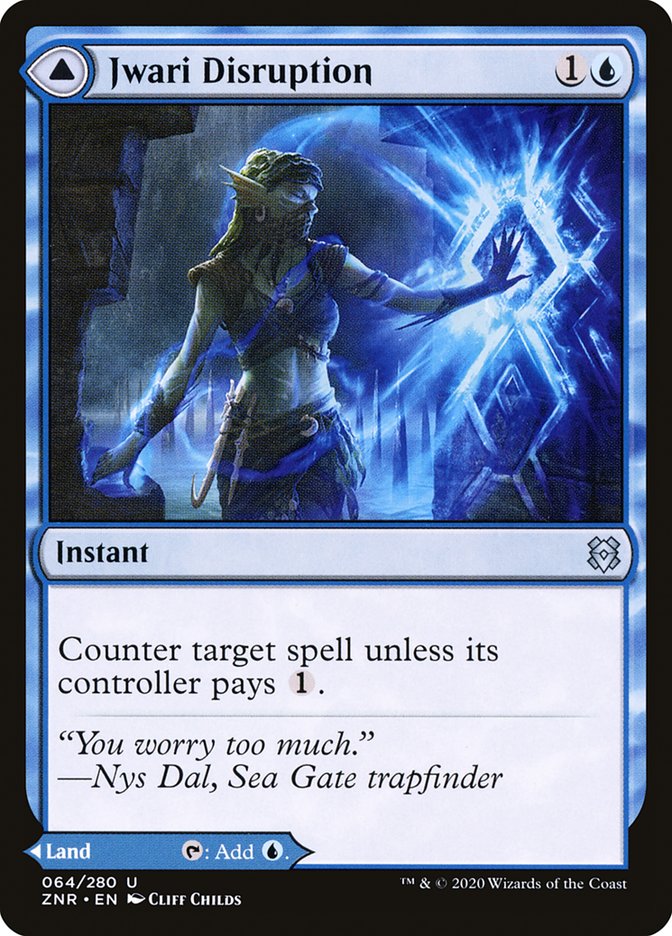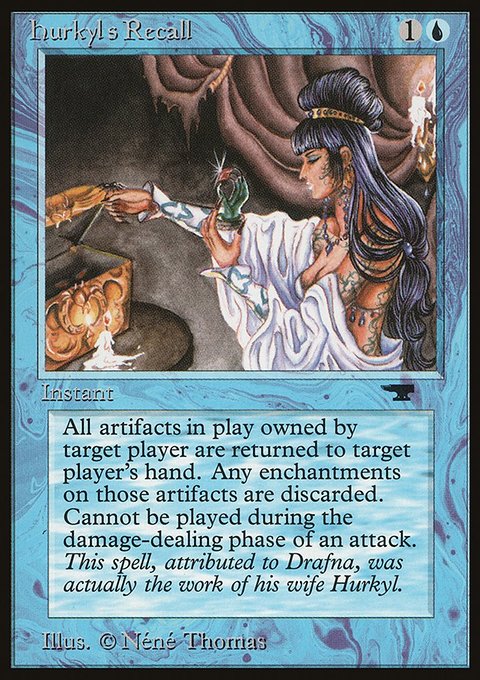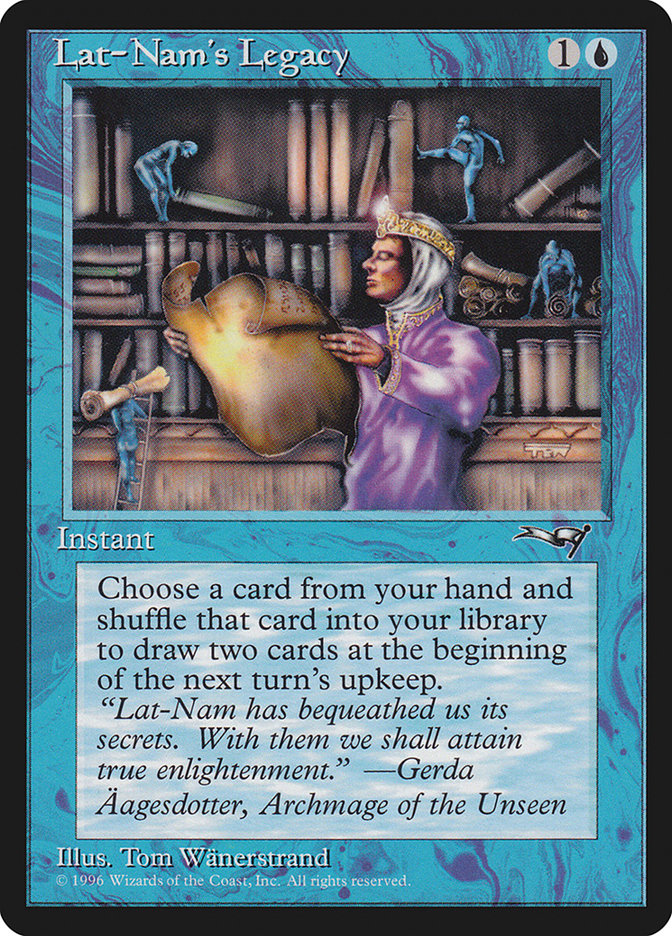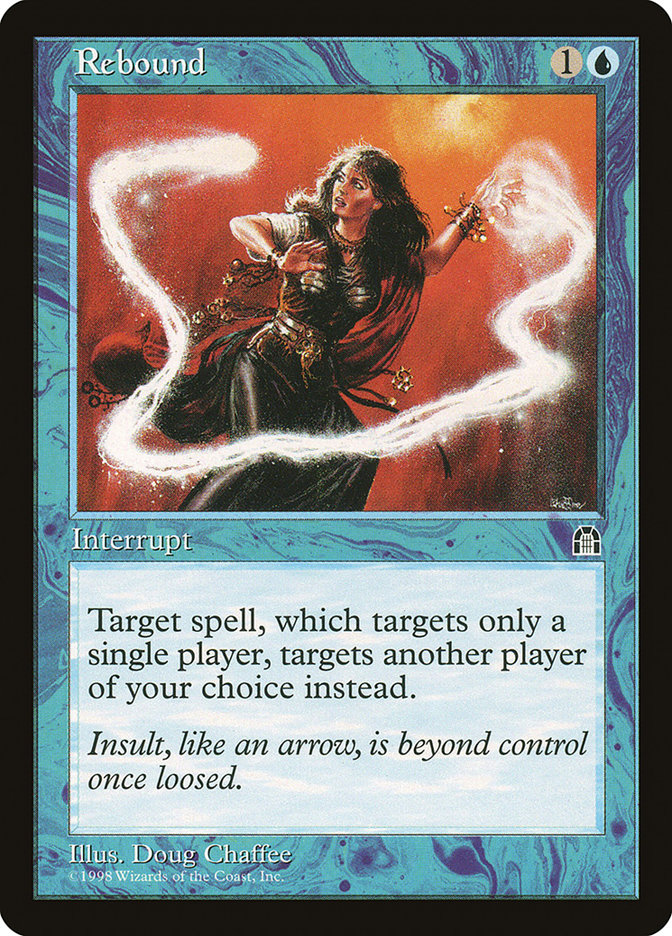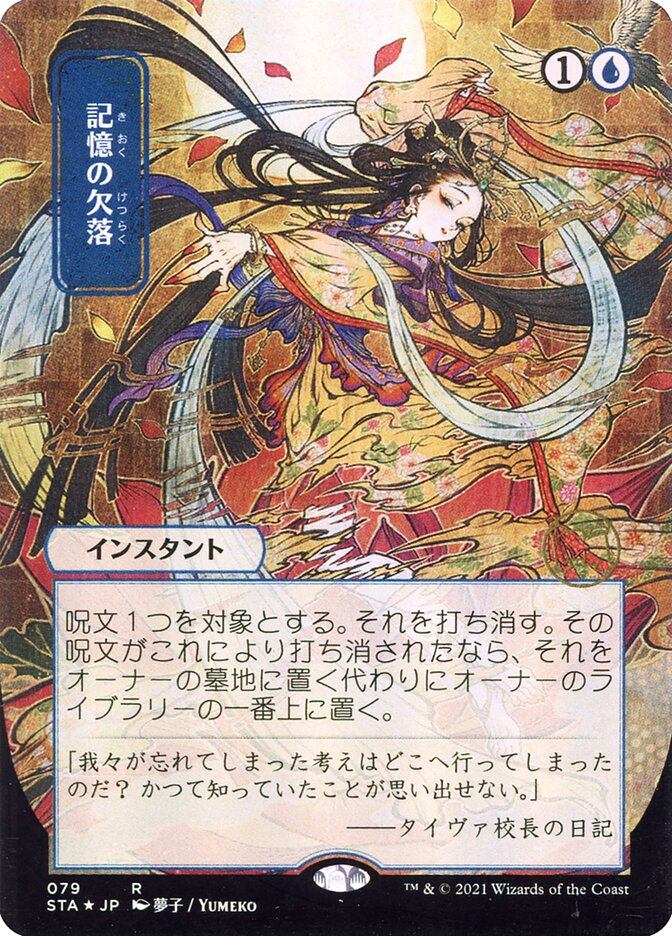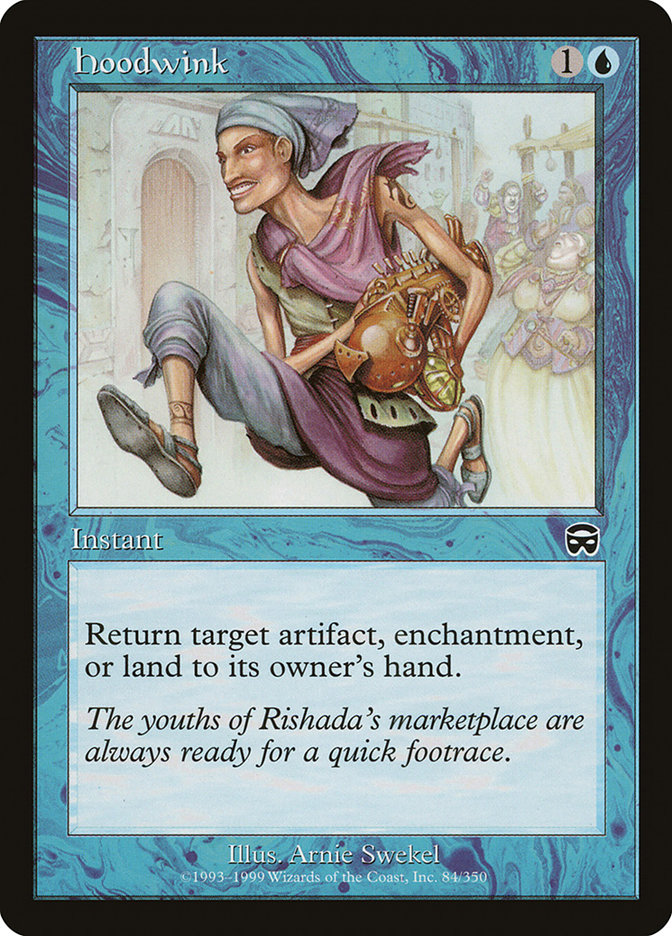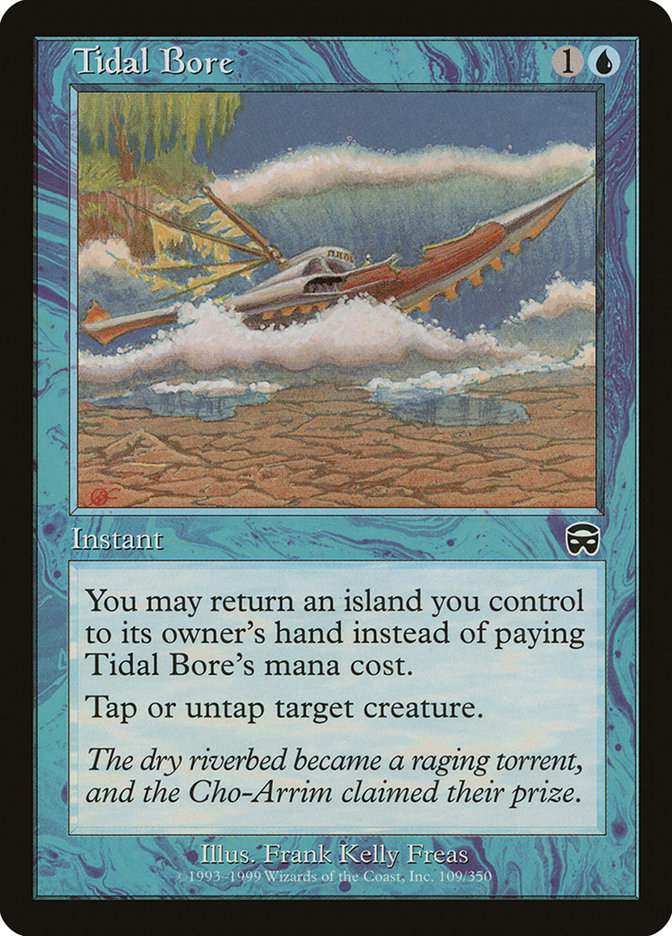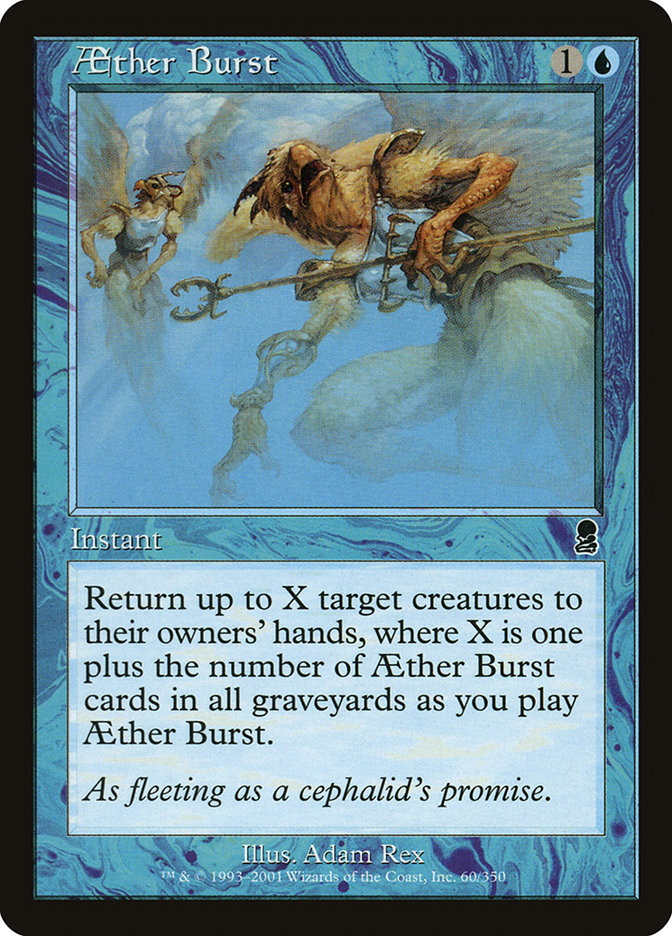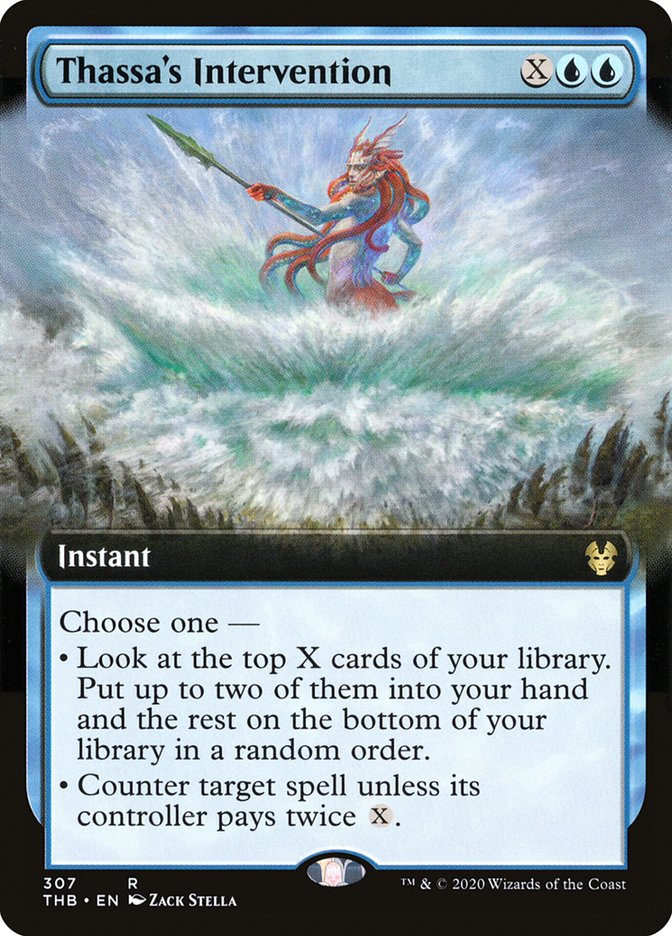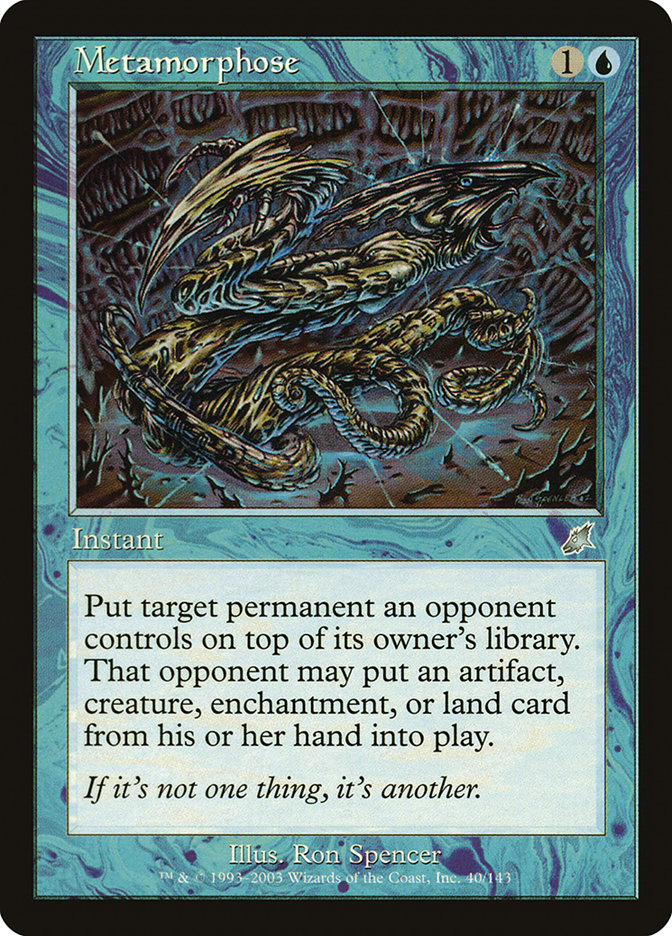Jwari Disruption // Jwari Ruins MTG Card
| Mana cost | |
| Converted mana cost | 2 |
| Rarity | Uncommon |
| Type | Instant |
| Released | 2020-09-25 |
| Set symbol | |
| Set name | Zendikar Rising |
| Set code | ZNR |
| Number | 64 |
| Frame | 2015 |
| Layout | Modal DFC |
| Border | Black |
| Illustred by | Cliff Childs |
Text of card
Counter target spell unless its controller pays .
"You worry too much." —Nys Dal, Sea Gate trapfinder
Cards like Jwari Disruption // Jwari Ruins
Jwari Disruption finds its place among flexible spells in Magic: The Gathering, sharing traits with modal dual-faced cards that provide both a land option and a disruptive effect. A close comparison is Silundi Vision, which digs deep into the deck for an instant or sorcery, doubling as a land when needed. While Jwari Disruption disrupts the opponent’s curve by countering a crucial spell, Silundi Vision bolsters your own hand selection instead.
Also vying for deck slots is Mystical Dispute, which costs less to counter target spells that are blue and remains relevant throughout all game phases for its capacity to target any spell, albeit at a higher cost. Where Jwari Disruption offers a land alternative, Mystical Dispute’s lower cost under specific conditions makes it a situational favorite.
Analyzing these options within Magic: The Gathering shows Jwari Disruption’s unique position. Its duality as both a mana source and a counter spell adds a layer of strategy, giving players the ability to adapt to the evolving state of the game.
Cards similar to Jwari Disruption // Jwari Ruins by color, type and mana cost
Card Pros
Card Advantage: Jwari Disruption serves not only as a counterspell but also flips to become Jwari Ruins, a land, effectively augmenting your hand by offering two types of resources in a single card. This versatility ensures that the card is rarely a dead draw, as it can be used as either a spell or a land depending on the situation.
Resource Acceleration: By doubling as a land, Jwari Disruption can contribute to your resource acceleration when played as Jwari Ruins. This means even if you don’t need the disruptive capabilities of the spell, you won’t miss a land drop, keeping your mana curve consistent and facilitating the casting of more powerful spells sooner.
Instant Speed: Jwari Disruption operates at instant speed, giving you the flexibility to react to your opponent’s moves. This responsiveness is crucial in controlling the flow of the game, allowing you to withhold mana and make strategic decisions based on the unfolding game state, potentially countering key spells in your opponent’s arsenal.
Card Cons
Discard Requirement: Jwari Disruption requires you to set it aside as a land, hence discarding potential plays. This can backfire when you’re in need of cards to react to your opponent’s moves.
Specific Mana Cost: This card demands blue mana, which pigeonholes it into blue-centric or two-color decks, potentially excluding it from a broader range of strategies.
Comparatively High Mana Cost: While it costs two mana to cast, other counterspells or disruptions cards either cost less or offer a stronger effect, making Jwari Disruption less competitive in terms of resource management.
Reasons to Include in Your Collection
Versatility: Jwari Disruption serves a dual purpose, acting as both a land and a spell. This flexibility allows it to fit seamlessly into a variety of decks, offering strategic counters when needed, or simply being played as a land when mana is key.
Combo Potential: As a spell, it can thwart an opponent’s early key play, setting you up for powerful follow-up combos. It’s especially potent in blue-based control decks where delaying opponents can be crucial for victory.
Meta-Relevance: With fast-paced and combo-heavy decks ubiquitous in the current metagame, Jwari Disruption provides a cost-effective way to disrupt early plays while still contributing to your mana base, making it a valuable asset in many competitive environments.
How to beat Jwari Disruption
Jwari Disruption is an intriguing card that poses a dual threat in Magic: The Gathering. On one side, it’s a land that comes into play tapped, but it can also be a tempo play, disrupting your opponent’s crucial spells. To effectively counter this card, it’s essential to stay aware of the open mana your opponent has, especially one blue mana. Playing around Jwari Disruption involves casting non-critical spells first when your opponent might have this card ready, or waiting until you have additional mana to pay for its counter ability.
Another strategy is to bait out the disruption. Since it is typically used in the early to mid-game, try to draw it out with less impactful spells that, if countered, won’t set you back significantly. Having more lands as you progress into the mid-game will also minimize Jwari Disruption’s effectiveness, making it a basic tapped land rather than a spell counter. Keep in mind that patience and calculated spell casting will often negate the setback that Jwari Disruption could have imposed on your game plan.
BurnMana Recommendations
Mastering the balance between land and spell utility is key in MTG, and Jwari Disruption offers just that. As a modal double-faced card, it’s a strategic addition to many decks. Whether it’s about hitting your land drops or keeping your opponent’s threats at bay, there’s always a place for versatility. It’s about understanding when to counter and when to develop your own game plan, making every decision impactful. We extend an invitation to refine your strategy and embrace the flexible power of Jwari Disruption. Dive deeper with us, and let’s navigate the multifaceted world of MTG together for your next victorious match!
Where to buy
If you're looking to purchase Jwari Disruption // Jwari Ruins MTG card by a specific set like Zendikar Rising, there are several reliable options to consider. One of the primary sources is your local game store, where you can often find booster packs, individual cards, and preconstructed decks from current and some past sets. They often offer the added benefit of a community where you can trade with other players.
For a broader inventory, particularly of older sets, online marketplaces like TCGPlayer, Card Kingdom and Card Market offer extensive selections and allow you to search for cards from specific sets. Larger e-commerce platforms like eBay and Amazon also have listings from various sellers, which can be a good place to look for sealed product and rare finds.
Additionally, Magic’s official site often has a store locator and retailer lists for finding Wizards of the Coast licensed products. Remember to check for authenticity and the condition of the cards when purchasing, especially from individual sellers on larger marketplaces.
Below is a list of some store websites where you can buy the Jwari Disruption // Jwari Ruins and other MTG cards:
 BUY NOW
BUY NOW BurnMana is an official partner of TCGPlayer
- eBay
- Card Kingdom
- Card Market
- Star City Games
- CoolStuffInc
- MTG Mint Card
- Hareruya
- Troll and Toad
- ABU Games
- Card Hoarder Magic Online
- MTGO Traders Magic Online
See MTG Products
Legalities
Magic the Gathering formats where Jwari Disruption // Jwari Ruins has restrictions
| Format | Legality |
|---|---|
| Historicbrawl | Legal |
| Commander | Legal |
| Historic | Legal |
| Legacy | Legal |
| Modern | Legal |
| Oathbreaker | Legal |
| Vintage | Legal |
| Duel | Legal |
| Explorer | Legal |
| Gladiator | Legal |
| Pioneer | Legal |
| Timeless | Legal |
Rules and information
The reference guide for Magic: The Gathering Jwari Disruption // Jwari Ruins card rulings provides official rulings, any errata issued, as well as a record of all the functional modifications that have occurred.
| Date | Text |
|---|---|
| 2020-09-25 | A modal double-faced card can’t be transformed or be put onto the battlefield transformed. Ignore any instruction to transform a modal double-faced card or to put one onto the battlefield transformed. |
| 2020-09-25 | If an effect allows you to play a land or cast a spell from among a group of cards, you may play or cast a modal double-faced card with any face that fits the criteria of that effect. |
| 2020-09-25 | If an effect allows you to play a specific modal double-faced card, you may cast it as a spell or play it as a land, as determined by which face you choose to play. If an effect allows you to cast (rather than “play”) a specific modal double-faced card, you can’t play it as a land. |
| 2020-09-25 | If an effect instructs a player to choose a card name, the name of either face may be chosen. If that effect or a linked ability refers to a spell with the chosen name being cast and/or a land with the chosen name being played, it considers only the chosen name, not the other face’s name. |
| 2020-09-25 | If an effect puts a double-faced card onto the battlefield, it enters with its front face up. If that front face can’t be put onto the battlefield, it doesn’t enter the battlefield. |
| 2020-09-25 | In the Commander variant, a double-faced card’s color identity is determined by the mana costs and mana symbols in the rules text of both faces combined. If either face has a color indicator or basic land type, those are also considered. |
| 2020-09-25 | The converted mana cost of a modal double-faced card is based on the characteristics of the face that’s being considered. On the stack and battlefield, consider whichever face is up. In all other zones, consider only the front face. This is different than how the converted mana cost of a transforming double-faced card is determined. |
| 2020-09-25 | There is a single triangle icon in the top left corner of the front face. There is a double triangle icon in the top left corner of the back face. |
| 2020-09-25 | To determine whether it is legal to play a modal double-faced card, consider only the characteristics of the face you’re playing and ignore the other face’s characteristics. |
